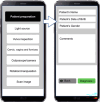The WHO atlas for female-genital schistosomiasis: Co-design of a practicable diagnostic guide, digital support and training
- PMID: 38498490
- PMCID: PMC10947668
- DOI: 10.1371/journal.pgph.0002249
The WHO atlas for female-genital schistosomiasis: Co-design of a practicable diagnostic guide, digital support and training
Erratum in
-
Correction: The WHO atlas for female-genital schistosomiasis: Co-design of a practicable diagnostic guide, digital support and training.PLOS Glob Public Health. 2024 Jun 14;4(6):e0003403. doi: 10.1371/journal.pgph.0003403. eCollection 2024. PLOS Glob Public Health. 2024. PMID: 38875219 Free PMC article.
Abstract
Up to 56 million young and adult women of African origin suffer from Female Genital Schistosomiasis (FGS). The transmission of schistosomiasis happens through contact with schistosomiasis infested fresh water in rivers and lakes. The transmission vector is the snail that releases immature worms capable of penetrating the human skin. The worm then matures and mates in the blood vessels and deposits its eggs in tissues, causing urogenital disease. There is currently no gold standard for FGS diagnosis. Reliable diagnostics are challenging due to the lack of appropriate instruments and clinical skills. The World Health Organisation (WHO) recommends "screen-and-treat" cervical cancer management, by means of visual inspection of characteristic lesions on the cervix and point-of-care treatment as per the findings. FGS may be mistaken for cervical cancer or sexually transmitted diseases. Misdiagnosis may lead to the wrong treatment, increased risk of exposure to other infectious diseases (human immunodeficiency virus and human papilloma virus), infertility and stigmatisation. The necessary clinical knowledge is only available to a few experts in the world. For an appropriate diagnosis, this knowledge needs to be transferred to health professionals who have minimal or non-existing laboratory support. Co-design workshops were held with stakeholders (WHO representative, national health authority, FGS experts and researchers, gynaecologists, nurses, medical doctors, public health experts, technical experts, and members of the public) to make prototypes for the WHO Pocket Atlas for FGS, a mobile diagnostic support tool and an e-learning tool for health professionals. The dissemination targeted health facilities, including remote areas across the 51 anglophone, francophone and lusophone African countries. Outcomes were endorsed by the WHO and comprise a practical diagnostic guide for FGS in low-resource environments.
Copyright: © 2024 Martinez et al. This is an open access article distributed under the terms of the Creative Commons Attribution License, which permits unrestricted use, distribution, and reproduction in any medium, provided the original author and source are credited.
Conflict of interest statement
The authors have declared that no competing interests exist.
Figures







References
-
- World Health Organization. Female genital schistosomiasis: A pocket atlas for clinical health-care professionals. Who/Htm/Ntd/20154 [Internet]. 2015. [cited 2023 Jun 16];2015(September 1). Available from: https://www.who.int/publications/i/item/9789241509299
-
- WHO. Colposcopy and treatment of cervical intraepithelial neoplasia: a beginners’ manual. Vol. 1, Colposcopy and Treatment of Cervical Intraepithelial Neoplasia: A Beginners’ Manual. 2003.
-
- Galappaththi-Arachchige HN, Holmen S, Koukounari A, Kleppa E, Pillay P, Sebitloane M, et al.. Evaluating diagnostic indicators of urogenital Schistosoma haematobium infection in young women: A cross sectional study in rural South Africa. PLoS One. 2018;13(2). doi: 10.1371/journal.pone.0191459 - DOI - PMC - PubMed
Grants and funding
LinkOut - more resources
Full Text Sources
Research Materials
